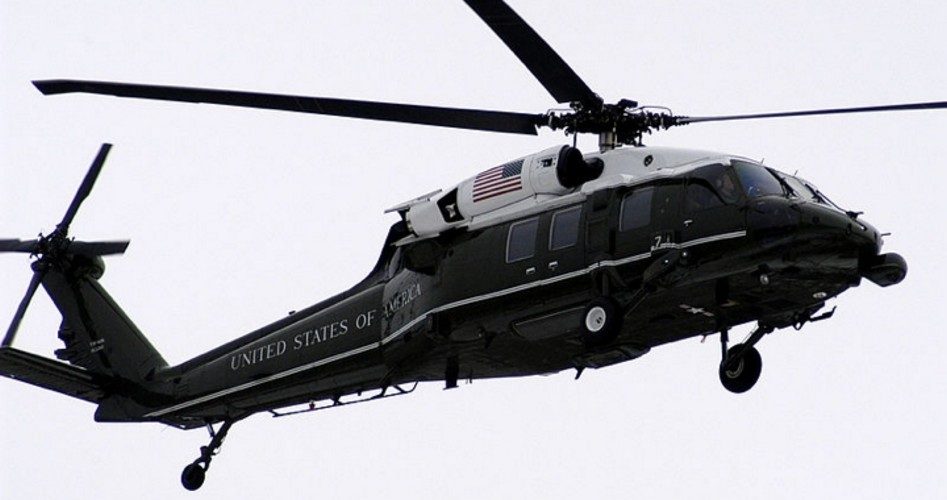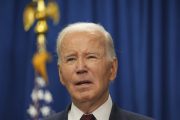
It didn’t take long for critics to scoff at the costs of the latest effort to upgrade the fleet of presidential helicopters announced by the Defense Department on Wednesday, May 7. They say the $1.2-billion contract awarded to Sikorsky Aircraft Corporation will be just the beginning.
There are at least two reasons to be skeptical: the open-ended nature of the White House requirements, and recent history.
The Department of Defense outlined its requirements, stating that Marine Helicopter Squadron One, which currently operates 19 presidential helicopters, must provide “safe and timely transportation for the President and Vice President of the United States, heads of state and others as directed by the White House Military Office.”
In addition, each aircraft must be equipped with various self-defense features such as bulletproof glass and body panels, as well as specialized communications equipment that allows the president to maintain “critical command functions” while airborne. Each helicopter must be large enough to carry up to 14 passengers and several thousand pounds of baggage while being small enough to operate from the White House lawn.
Each must have a minimum range of 300 miles and carry a full complement of defensive countermeasures to thwart heat-seeking and radar-directed missiles and also be hardened against an EMP (electromagnetic pulse), either from an enemy or from the sun. It must be able to send and receive encrypted communications and hold secure teleconferences while in flight.
And each must have air-conditioning and a toilet.
Under the contract Sikorsky promises to deliver two prototypes by 2016, with another 21 fully operational aircraft six years later.
Several questions arise. First, why so many? After all, there’s just one president and one vice president. According to Helimart.com, anytime the president flies somewhere by helicopter, four other helicopters are alongside him. They fly in varying formations to keep the president’s aircraft as disguised as possible. This is often referred to as the presidential “shell game.” In addition, with a helicopter’s range of just 300 miles, a longer trip must “cache” additional aircraft along the route.
Secondly, why not continue to use the current fleet of 19? The official answer is age: Most of the helicopters were built when Obama was just 14 years old. With the passage of time, even with continuing upgrades, the demands for new equipment, technology, and defensive requirements have added so much weight that the current airframes are no longer sufficient.
Following the 9/11 attacks, pressure mounted on the military to upgrade the presidential helicopter fleet, which at the time was already more than 15 years old. In January 2005 the Navy awarded the upgrade contract to Lockheed Martin to develop and build 23 helicopters at a bid price of $6.1 billion. By March 2008, the cost of the program had exploded to more than $11 billion, triggering outrage from Congress and a legislative “cap” on the program. With 2008 being an election year, politicians seized on the overruns as another example of government spending run amok. Senator John McCain pointed out that each helicopter would cost as much as a single Air Force One 747. Lockheed Martin blamed the Navy, saying that it had added some 1,900 extra requirements after the contract had been signed. The Navy said there were no additional requirements added, but instead that there was an “incomplete understanding” about the deal.
On April 9, 2009, Secretary of Defense Robert Gates had the last word:
This program was originally designed to provide 23 helicopters to support the president at a cost of $6.5 billion. Today, the program is estimated to cost over $13 billion, has fallen six years behind schedule, and runs the risk of not delivering the requested capabilit[ies]…. I recommend that we terminate the … presidential helicopter [program].
A month later, Congress was informed that the cancelled program had cost taxpayers $3.2 billion “with no operational aircraft delivered,” while the Government Accountability Office said that the real costs of cancelling the program “were unknown.”
Naturally, a new program was begun immediately to replace the aging presidential helicopters, and the contract awarded last week is just the first step on another long, indefinite, and costly journey. There are deadlines, of course: The 23 helicopters are to be operational, in the air, by 2022.
When the 2005 helicopter development program was cancelled in 2009, the Congressional Research Service noted the new program would likely cost $10-17 billion “depending on the operational requirements that are established for the program.” And that doesn’t include the costs to keep the existing 19 presidential helicopters in operation until they are retired by the new ones. With inflation, new technology, and the government’s general propensity to expand any new program far beyond its original intent or estimate, by the time the new aircraft are airborne, they could easily cost twice what they did at the time of the cancellation of the previous upgrade.
This time, however, the ballooning of the program can’t be blamed on Obama. By the time the new helicopters arrive in 2022, Obama will have been out of office five years.
Photo of Marine One over Washington, D.C.
A graduate of Cornell University and a former investment advisor, Bob is a regular contributor to The New American magazine and blogs frequently at www.LightFromTheRight.com, primarily on economics and politics.



